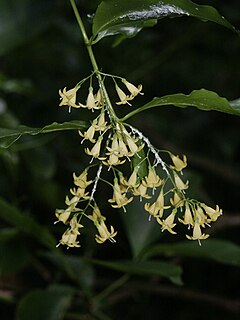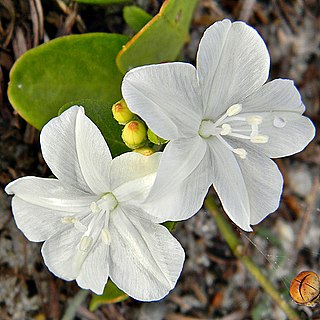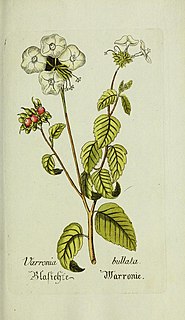Lasiocroton is a plant genus of the family Euphorbiaceae first described as a genus in 1859. The genus is endemic to the West Indies.
- Lasiocroton bahamensisPax & K.Hoffm. - Bahamas, Cuba, Haiti
- Lasiocroton fawcettiiUrb. - Jamaica
- Lasiocroton gracilisBritton & P.Wilson - SE Cuba
- Lasiocroton gutierreziiJestrow - Cuba
- Lasiocroton harrisiiBritton - Jamaica
- Lasiocroton macrophyllus(Sw.) Griseb. - Jamaica
- Lasiocroton microphyllus(A.Rich.) Jestrow - Cuba
- moved to other genera (Bernardia Croton Leucocroton)
- Lasiocroton cordifoliusBritton & P.Wilson - Leucocroton cordifolius (Britton & P.Wilson) Alain
- Lasiocroton prunifoliusGriseb. - Croton punctatusJacq.
- Lasiocroton subpeltatusUrb. - Leucocroton subpeltatus(Urb.) Alain
- Lasiocroton trelawniensisC.D.Adams - Bernardia trelawniensis(C.D.Adams) Jestrow & Proctor

Chaetocarpus is a plant genus of the family Peraceae, formerly Euphorbiaceae, first described as a genus in 1854. Chaetocarpus species are trees or shrubs. There native to the Americas, Africa, and Asia. Some species are endangered.
- Chaetocarpus acutifolius(Britton & P.Wilson) Borhidi - Sierra de Moa in Cuba
- Chaetocarpus africanusPax - C Africa
- Chaetocarpus castanocarpus(Roxb.) Thwaites - SE Asia, Yunnan, Assam, Bangladesh, Sri Lanka
- Chaetocarpus cordifolius(Urb.) Borhidi - Cuba, Hispaniola, Jamaica
- Chaetocarpus coriaceusThwaites - Sri Lanka
- Chaetocarpus cubensisFawc. & Rendle - Cuba
- Chaetocarpus echinocarpus (Baill.) Ducke - Bolivia, Brazil
- Chaetocarpus ferrugineusPhilcox - Sri Lanka
- Chaetocarpus gabonensisBreteler - Gabon
- Chaetocarpus globosus(Sw.) Fawc. & Rendle - Jamaica, Cuba, Dominican Rep.
- Chaetocarpus myrsinitesBaill. - Bolivia, Brazil
- Chaetocarpus parvifoliusBorhidi - Cuba
- Chaetocarpus pearceiRusby - Bolivia
- Chaetocarpus pubescens(Thwaites) Hook.f. - Sri Lanka
- Chaetocarpus rabarabaCapuron - Madagascar
- Chaetocarpus schomburgkianus(Kuntze) Pax & K.Hoffm. - Colombia, Venezuela, 3 Guianas, NW Brazil

Calyptranthes is a genus of flowering plants in the family Myrtaceae. They are known commonly as lidflowers, spicewoods, and mountainbays. There are about 100 species.

Sideroxylon is a genus of trees in the family Sapotaceae described as a genus by Linnaeus in 1753. They are collectively known as bully trees. The generic name is derived from the Greek words σιδηρος (sideros), meaning "iron", and ξύλον (xylon), meaning "wood."
Auerodendron is a genus of plant in family Rhamnaceae.

Casasia is a genus of flowering plants in the family Rubiaceae. These shrubs or small trees occur on the Caribbean islands and in one case in Florida. Some of the ten accepted species were formerly placed elsewhere, e.g. in the related genip-tree genus (Genipa), in Gardenia or in Randia.

Exostema is a genus of flowering plants in the family Rubiaceae. It consists of trees and shrubs, endemic to the neotropics, with most of the species occurring in the West Indies.

Harpalyce is a genus of flowering plants in the legume family, Fabaceae. It belongs to the subfamily Faboideae.

Chiococca is a genus of flowering plants in the family Rubiaceae. It currently holds 23 species that are native to Florida, Texas, Mexico, Central America, much of South America, the West Indies, and the Galápagos.
Acrosynanthus is a genus of flowering plants in the family Rubiaceae. It is found in Cuba and Jamaica in the Caribbean.

Rondeletieae is a tribe of flowering plants in the family Rubiaceae and contains about 178 species in 8 genera. Its representatives are found from southern Mexico to northern South America and in the Caribbean.
Neobracea is a genus of plant in the family Apocynaceae first described as a genus in 1905. It was first given the name Bracea, but this turned out to be an illegitimate homonym. In other words, somebody else had already used it for another plant. Neobracea is native to Cuba and the Bahamas.
- Neobracea acunanaLippold - E Cuba
- Neobracea angustifoliaBritton - W Cuba
- Neobracea bahamensis(Britton) Britton - Bahamas, Cuba
- Neobracea ekmaniiUrb. - E Cuba
- Neobracea howardiiWoodson - EC Cuba
- Neobracea martianaBorhidi & O.Muñiz - E Cuba
- Neobracea susanninaBorhidi - E Cuba
- Neobracea valenzuelana(A.Rich.) Urb. - Cuba

Leucocroton havanensis is an endemic species to Cuba. It is located on serpentine soils and limestone rock in the western and central part of the country. It is an evergreen tree that has dioecious flowering, meaning the species has distinct male and female individuals. The plant only grows on a small serpentine island.

Jacquemontia is a genus of plants in the morning glory family Convolvulaceae. Species in this genus are commonly known as clustervine.

Mitracarpus is a plant genus in the coffee family Rubiaceae. Girdlepod is a common name for some species in this genus.

Varronia is a genus of flowering plants in the family Boraginaceae, found throughout Latin America, the Caribbean, and in the US states of Texas and Florida. They were resurrected from Cordia in 2007.
Sapphoa is a genus of flowering plants in the family Acanthaceae, native to Cuba. Adapted to serpentine soils, they are nickel hyperaccumulators.










